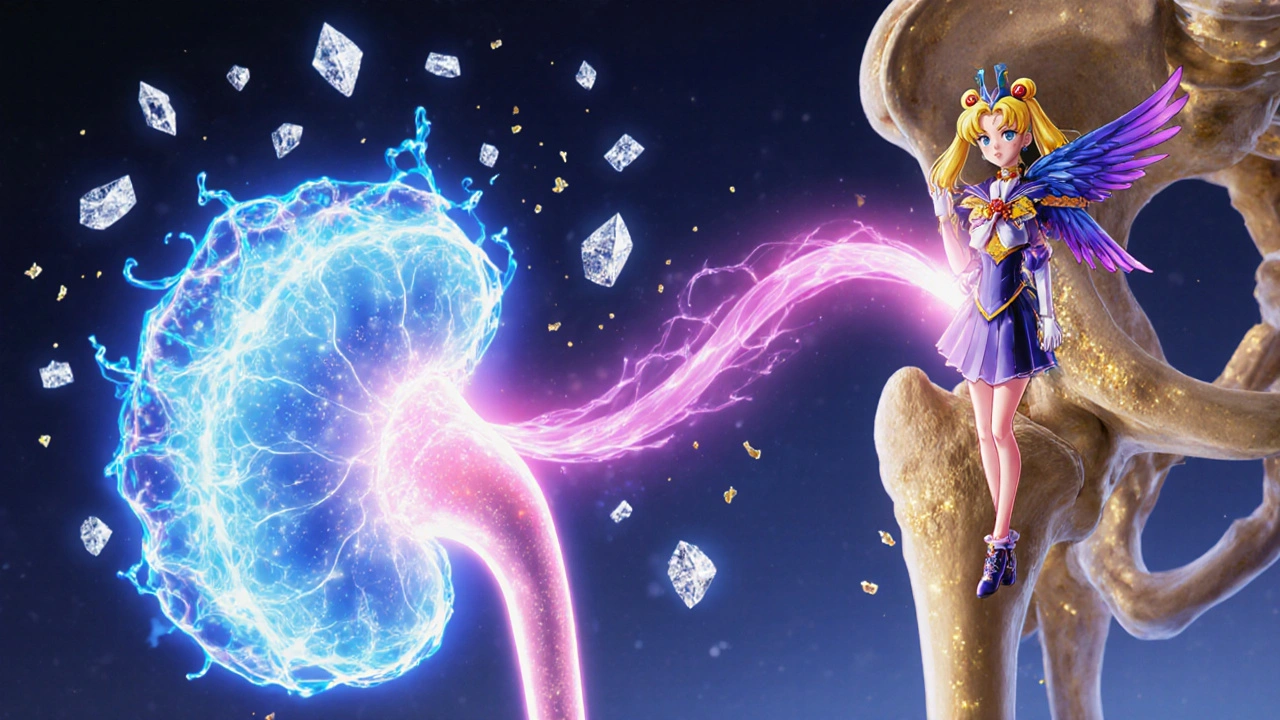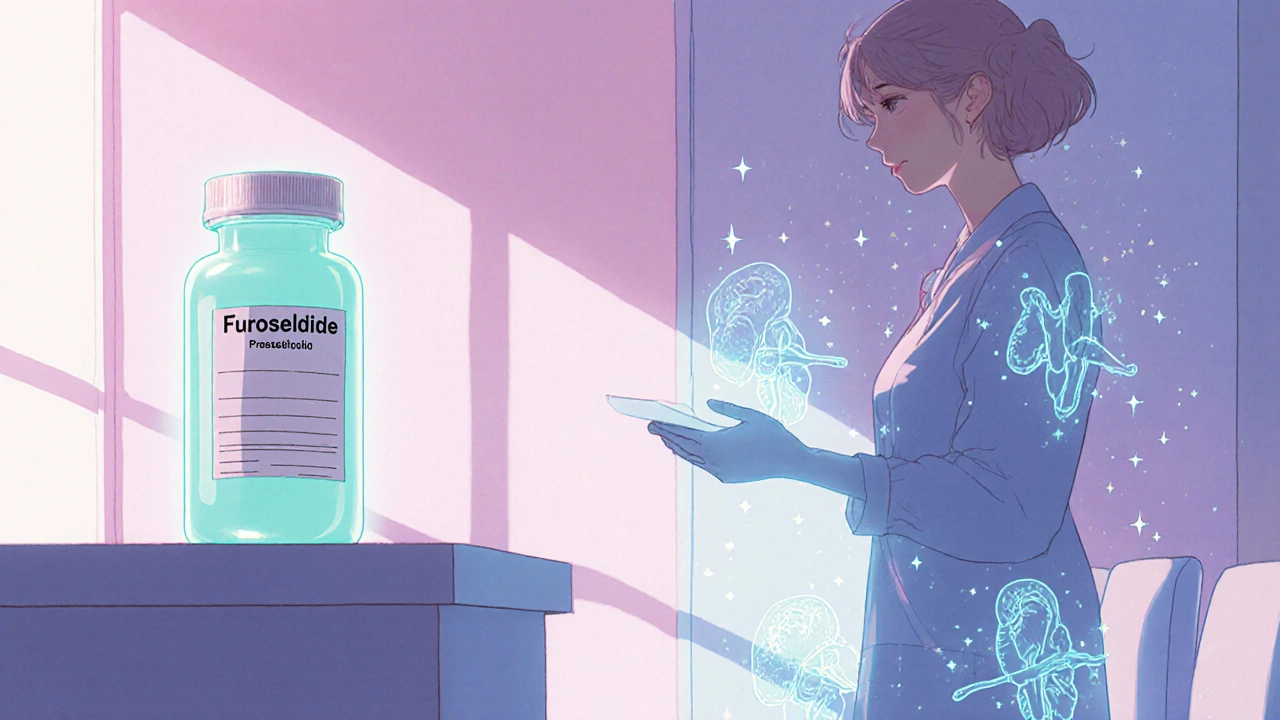Furosemide Bone Health Risk Calculator
Bone Health Risk Assessment
Personalized Bone Health Report
Bone Protection Recommendations
Note: This tool estimates bone health risk based on clinical data from the article. Always consult your healthcare provider for medical advice.
When doctors prescribe Furosemide for swelling or high blood pressure, most patients focus on the rapid fluid loss. Few think about the silent impact on their skeleton. In the next few minutes you’ll discover why this common loop diuretic can tip the balance of bone remodeling, which groups are most vulnerable, and which simple steps can keep your bones strong while staying on the medication.
What is Furosemide and How Does It Work?
Furosemide is a potent loop diuretic that blocks the Na‑K‑2Cl cotransporter in the thick ascending limb of the nephron, causing the kidneys to excrete large volumes of sodium, chloride, and water. The result is a rapid drop in extracellular fluid, making it a first‑line therapy for edema linked to heart failure, liver cirrhosis, and chronic kidney disease. Because it works higher up in the renal tubule than thiazide diuretics, the loss of electrolytes-especially calcium, magnesium, and potassium-is more pronounced.
Why Calcium Matters for Your Bones
Calcium is the primary mineral stored in bone, providing the structural framework that gives skeletons their strength and rigidity. About 99% of the body’s calcium resides in bones and teeth; the remaining 1% circulates in blood, supporting nerve transmission, muscle contraction, and hormone secretion. When dietary calcium intake falls short, the body pulls calcium from bone to maintain serum levels, a process called bone resorption.
Loop Diuretics vs. Thiazide Diuretics: A Bone Perspective
Not all diuretics affect bone the same way. Thiazides actually reduce urinary calcium loss, offering a protective effect, whereas loop diuretics like furosemide increase calcium excretion. The table below highlights the key differences.
| Aspect | Loop Diuretics (e.g., Furosemide) | Thiazide Diuretics (e.g., Hydrochlorothiazide) |
|---|---|---|
| Site of action in nephron | Thick ascending limb | Distal convoluted tubule |
| Calcium excretion | Increases urinary calcium loss | Decreases urinary calcium loss |
| Impact on bone density (clinical data) | Associated with modest ↓ BMD over years | Linked to modest ↑ BMD or stability |
| Common side effects | Electrolyte imbalance, ototoxicity | Hyperglycemia, hyperuricemia |
Electrolyte Imbalance: The Hidden Bridge to Bone Loss
Electrolyte imbalance refers to abnormal levels of minerals like potassium, magnesium, and especially calcium in the blood. When furosemide flushes out these ions, the body reacts by releasing parathyroid hormone (PTH) to pull calcium from bone, aiming to restore serum calcium. Chronic elevation of PTH-a condition known as secondary hyperparathyroidism-accelerates bone turnover, tilting the balance toward resorption.
The Role of Parathyroid Hormone in Bone Remodeling
Parathyroid hormone (PTH) is secreted by the parathyroid glands whenever blood calcium drops, signaling bone‑lining cells to release stored calcium into the bloodstream. While short‑term spikes can stimulate bone formation, continuous high levels tip the scale toward breakdown, weakening trabecular and cortical bone. In patients using high‑dose furosemide, regular monitoring of PTH can reveal early warning signs of skeletal risk.
Kidney Health: The Starting Point of the Cascade
Kidney function determines how efficiently the body can reabsorb minerals after they are filtered. Loop diuretics act directly on the kidney’s nephrons, so any pre‑existing renal impairment magnifies calcium loss. Moreover, reduced kidney function hampers the activation of vitamin D, a crucial co‑factor for calcium absorption in the gut.

Vitamin D: The Unsung Partner
Vitamin D facilitates intestinal calcium uptake and works hand‑in‑hand with PTH to maintain bone mineralization. Patients on furosemide often present with lower 25‑hydroxy‑vitamin D levels, especially if they have limited sun exposure or dietary intake. Ensuring adequate vitamin D (800-1,200 IU daily for most adults) can blunt the bone‑loss signal triggered by electrolyte shifts.
Clinical Evidence: What Studies Show
Several longitudinal studies have tracked bone mineral density (BMD) in patients on chronic loop diuretics. A 2022 meta‑analysis of 12 cohorts (over 9,000 participants) reported a mean lumbar spine BMD reduction of 0.03 g/cm² after five years of furosemide therapy, translating to a roughly 5% higher fracture risk compared with non‑users. Another registry from the US Kidney Disease Outcomes Quality Initiative (2023) found that patients with end‑stage renal disease on high‑dose loop diuretics had a 1.4‑fold increased odds of vertebral fractures.
However, not every patient will experience clinically relevant bone loss. Factors such as age, baseline BMD, gender, dosage, and concurrent use of calcium‑sparing agents (e.g., bisphosphonates) dictate the final outcome.
Who Is Most at Risk?
- Elderly women - post‑menopausal bone turnover already favors resorption.
- Patients with chronic kidney disease - impaired vitamin D activation and baseline electrolyte disturbances.
- Long‑term high‑dose users - doses >80 mg/day for more than a year.
- Individuals with low dietary calcium or vitamin D - diet cannot compensate for renal loss.
Monitoring Bone Health While on Furosemide
Proactive surveillance can catch bone loss before a fracture occurs. Recommended checks include:
- Baseline dual‑energy X‑ray absorptiometry (DXA) scan before initiating therapy, especially for high‑risk groups.
- Serum calcium, phosphorus, magnesium, and PTH levels every 6-12 months.
- Annual 25‑hydroxy‑vitamin D measurement.
- Repeat DXA at 2‑year intervals to track BMD trends.
Any downward trend in BMD greater than 2% per year warrants a therapeutic review.
Strategies to Safeguard Your Bones
Even if you need to stay on furosemide, you can adopt several evidence‑based tactics:
- Calcium supplementation: 1,000-1,200 mg of elemental calcium daily, split between meals for better absorption.
- Vitamin D optimization: Aim for serum 25‑OH‑D >30 ng/mL; consider 800-1,200 IU/day or higher if deficient.
- Magnesium intake: 300-400 mg daily reduces secondary PTH spikes.
- Weight‑bearing exercise: 30 minutes of brisk walking or resistance training most days improves bone formation.
- Alternative diuretic strategies: If clinically feasible, switching to a thiazide or a lower furosemide dose can lower calcium loss.
- Discuss with your prescriber; never alter dose on your own.
- Bone‑protective medications: In high‑risk individuals, bisphosphonates (e.g., alendronate) or denosumab may be prescribed.
Potential Pitfalls and Red Flags
Watch for symptoms that could herald worsening bone health:
- Sudden or unexplained back pain - may signal vertebral fracture.
- Height loss or stooped posture.
- Frequent falls or balance issues.
- Laboratory trends: rising PTH, falling calcium despite supplements.
If any of these appear, schedule an urgent appointment for imaging and lab review.

Bottom Line: Balancing Fluid Control with Skeletal Safety
Furosemide remains a life‑saving drug for fluid overload, but its impact on calcium balance can erode bone over time. By understanding the physiology, monitoring critical labs, and adding bone‑supporting measures, you can keep both your kidneys and your skeleton happy.
Does short‑term furosemide use affect bone health?
Short bursts (a few days to a couple of weeks) usually cause only transient calcium loss that the body can replace quickly. Significant bone loss typically requires months to years of continuous high‑dose therapy.
Should I stop taking furosemide if I have osteoporosis?
Never stop a prescribed medication without your doctor's guidance. Instead, discuss dose reduction, alternative diuretics, and bone‑protective strategies such as calcium, vitamin D, and possibly bisphosphonates.
How much calcium should I take while on furosemide?
Aim for 1,000 mg per day for adults under 50 and 1,200 mg for those over 50, divided into two doses. Pair with vitamin D to improve absorption.
Can vitamin D supplements counteract furosemide‑induced bone loss?
Vitamin D alone won’t stop calcium loss, but it enhances intestinal calcium uptake, reduces PTH spikes, and overall supports bone health when combined with adequate calcium.
Is there a test to measure bone loss caused by furosemide?
Dual‑energy X‑ray absorptiometry (DXA) is the standard tool to assess bone mineral density. Serial DXA scans can reveal any accelerated loss while on therapy.

Jinny Shin
October 23, 2025 AT 15:53Furosemide's impact on bone health is rarely front‑page news, yet the physiology behind it is a drama of electrolytes that plays out silently in our skeletons. When the loop diuretic forces the kidneys to dump sodium, chloride, and huge volumes of water, it also drags calcium, magnesium and potassium along for the ride. The sudden dip in serum calcium triggers the parathyroid glands to secrete PTH, a hormone that summons calcium from the bone reservoir. Over weeks and months this repeated signal tilts the remodeling balance toward resorption, especially in cortical bone where density loss is most evident. Elderly women, already facing post‑menopausal hormonal shifts, feel a double whammy when they add high‑dose furosemide to the mix. Patients with chronic kidney disease suffer two blows: diminished vitamin D activation and an amplified calcium leak, which together accelerate secondary hyperparathyroidism. Studies have shown a modest but measurable reduction in lumbar spine BMD after five years of chronic therapy, translating into a roughly five percent higher fracture risk. Yet the data also reveal a wide variability; those who maintain adequate dietary calcium and vitamin D often escape serious bone loss. A baseline DXA before starting the drug can serve as a benchmark, and serial scans every two years catch trends before a fracture occurs. Interventions are straightforward: split calcium supplements into two doses, ensure vitamin D levels above 30 ng/mL, and consider a magnesium supplement to blunt PTH spikes. Weight‑bearing exercise, such as brisk walking or resistance training, adds mechanical load that stimulates osteoblast activity. For patients on the highest doses, clinicians may contemplate switching to a thiazide diuretic, which actually reduces urinary calcium loss. In extreme cases, bone‑protective agents like bisphosphonates or denosumab can be introduced under specialist guidance. The key is not to abandon furosemide, a life‑saving medication, but to pair it with a bone‑health regimen that mitigates its hidden costs. Ultimately, awareness of the cascade-from renal electrolyte loss to skeletal compromise-empowers both doctors and patients to protect the skeletal scaffolding while managing fluid overload.
deepak tanwar
November 4, 2025 AT 08:06The clinical significance of furosemide‑induced bone loss is modest for most patients. Randomized trials have yet to demonstrate a causal link between standard doses and clinically relevant fractures. The body's homeostatic mechanisms compensate for transient calcium losses, especially when dietary intake is sufficient. Overemphasizing this risk may deter physicians from prescribing a drug that saves lives in heart failure and cirrhosis. Therefore, clinicians should weigh the modest BMD changes against the proven mortality benefit.
Simon Waters
November 16, 2025 AT 03:26Furosemide makes you pee a lot and also loses calcium. Your body then takes calcium from bones to keep blood levels normal. This can make bones weaker over time if you stay on it for years. Eating more dairy and getting sunshine can help.
Vikas Kumar
November 27, 2025 AT 22:46The Indian subcontinent has a massive burden of hypertension and edema, so furosemide is used everywhere. Yet many forget that our traditional diets are already low in calcium, making the drug a double‑edged sword for our people. Adding calcium‑rich foods like paneer or fortified milk is essential when the prescription is written. Without this, we risk a silent epidemic of fractures in our ageing citizens.
Celeste Flynn
December 9, 2025 AT 18:06Here’s a quick checklist for anyone on furosemide keep your calcium intake around 1,200 mg daily split doses get vitamin D supplements aiming for 30 ng/ml serum level check magnesium 300‑400 mg daily stay active with weight‑bearing exercise and schedule a DXA scan every two years it’s simple but effective
Shan Reddy
December 9, 2025 AT 19:30Totally agree – I’ve been doing the split calcium thing and it feels like my energy’s steadier.